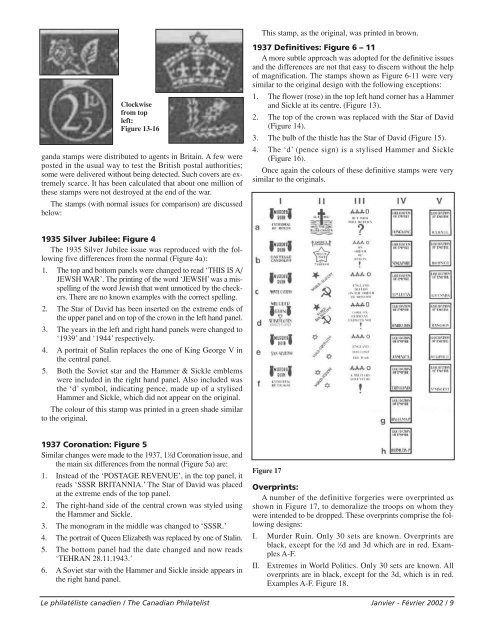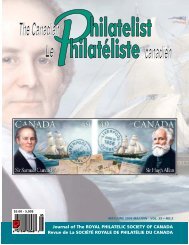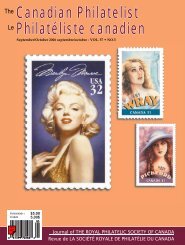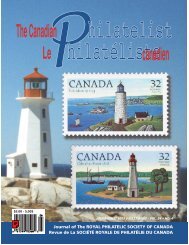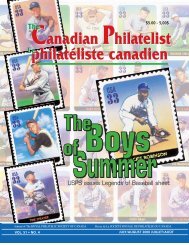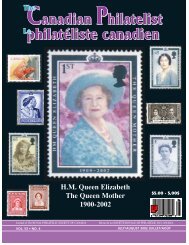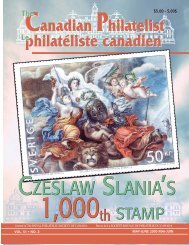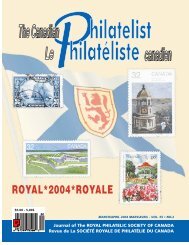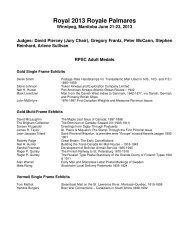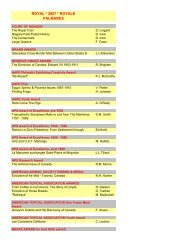Phil Pages Jan.Feb.2002 - The Royal Philatelic Society of Canada
Phil Pages Jan.Feb.2002 - The Royal Philatelic Society of Canada
Phil Pages Jan.Feb.2002 - The Royal Philatelic Society of Canada
You also want an ePaper? Increase the reach of your titles
YUMPU automatically turns print PDFs into web optimized ePapers that Google loves.
This stamp, as the original, was printed in brown.<br />
Clockwise<br />
from top<br />
left:<br />
Figure 13-16<br />
ganda stamps were distributed to agents in Britain. A few were<br />
posted in the usual way to test the British postal authorities;<br />
some were delivered without being detected. Such covers are extremely<br />
scarce. It has been calculated that about one million <strong>of</strong><br />
these stamps were not destroyed at the end <strong>of</strong> the war.<br />
<strong>The</strong> stamps (with normal issues for comparison) are discussed<br />
below:<br />
1937 Definitives: Figure 6 – 11<br />
A more subtle approach was adopted for the definitive issues<br />
and the differences are not that easy to discern without the help<br />
<strong>of</strong> magnification. <strong>The</strong> stamps shown as Figure 6-11 were very<br />
similar to the original design with the following exceptions:<br />
1. <strong>The</strong> flower (rose) in the top left hand corner has a Hammer<br />
and Sickle at its centre. (Figure 13).<br />
2. <strong>The</strong> top <strong>of</strong> the crown was replaced with the Star <strong>of</strong> David<br />
(Figure 14).<br />
3. <strong>The</strong> bulb <strong>of</strong> the thistle has the Star <strong>of</strong> David (Figure 15).<br />
4. <strong>The</strong> ‘d’ (pence sign) is a stylised Hammer and Sickle<br />
(Figure 16).<br />
Once again the colours <strong>of</strong> these definitive stamps were very<br />
similar to the originals.<br />
1935 Silver Jubilee: Figure 4<br />
<strong>The</strong> 1935 Silver Jubilee issue was reproduced with the following<br />
five differences from the normal (Figure 4a):<br />
1. <strong>The</strong> top and bottom panels were changed to read ‘THIS IS A/<br />
JEWSH WAR’. <strong>The</strong> printing <strong>of</strong> the word ‘JEWSH’ was a misspelling<br />
<strong>of</strong> the word Jewish that went unnoticed by the checkers.<br />
<strong>The</strong>re are no known examples with the correct spelling.<br />
2. <strong>The</strong> Star <strong>of</strong> David has been inserted on the extreme ends <strong>of</strong><br />
the upper panel and on top <strong>of</strong> the crown in the left hand panel.<br />
3. <strong>The</strong> years in the left and right hand panels were changed to<br />
‘1939’ and ‘1944’ respectively.<br />
4. A portrait <strong>of</strong> Stalin replaces the one <strong>of</strong> King George V in<br />
the central panel.<br />
5. Both the Soviet star and the Hammer & Sickle emblems<br />
were included in the right hand panel. Also included was<br />
the ‘d’ symbol, indicating pence, made up <strong>of</strong> a stylised<br />
Hammer and Sickle, which did not appear on the original.<br />
<strong>The</strong> colour <strong>of</strong> this stamp was printed in a green shade similar<br />
to the original.<br />
1937 Coronation: Figure 5<br />
Similar changes were made to the 1937, 1 1 ⁄2d Coronation issue, and<br />
the main six differences from the normal (Figure 5a) are:<br />
1. Instead <strong>of</strong> the ‘POSTAGE REVENUE’, in the top panel, it<br />
reads ‘SSSR BRITANNIA.’ <strong>The</strong> Star <strong>of</strong> David was placed<br />
at the extreme ends <strong>of</strong> the top panel.<br />
2. <strong>The</strong> right-hand side <strong>of</strong> the central crown was styled using<br />
the Hammer and Sickle.<br />
3. <strong>The</strong> monogram in the middle was changed to ‘SSSR.’<br />
4. <strong>The</strong> portrait <strong>of</strong> Queen Elizabeth was replaced by one <strong>of</strong> Stalin.<br />
5. <strong>The</strong> bottom panel had the date changed and now reads<br />
‘TEHRAN 28.11.1943.’<br />
6. A Soviet star with the Hammer and Sickle inside appears in<br />
the right hand panel.<br />
Figure 17<br />
Overprints:<br />
A number <strong>of</strong> the definitive forgeries were overprinted as<br />
shown in Figure 17, to demoralize the troops on whom they<br />
were intended to be dropped. <strong>The</strong>se overprints comprise the following<br />
designs:<br />
I. Murder Ruin. Only 30 sets are known. Overprints are<br />
black, except for the 1 ⁄2d and 3d which are in red. Examples<br />
A-F.<br />
II. Extremes in World Politics. Only 30 sets are known. All<br />
overprints are in black, except for the 3d, which is in red.<br />
Examples A-F. Figure 18.<br />
Le philatéliste canadien / <strong>The</strong> Canadian <strong>Phil</strong>atelist <strong>Jan</strong>vier - Février 2002 / 9


